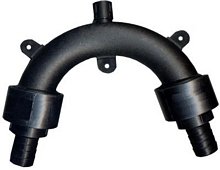SASSY
Member II
We were sailing our '87 E-34 from Atlantic City to Sandy Hook, New Jersey yesterday when an alarming situation arose, the cabin sole on the starboard side of the boat had 2 to 3 inches of water across it and both bilge pumps were running. I inspected all the through hulls from bow to stern to no avail, and then I recalled a predicament that a friend of mine experienced on a crossing to the Azores. We were on a port tack all the way up the coast, causing the through hulls for the bilge pumps to submerge, when the pumps ended their cycle and shut off the resulting back flow caused a siphon effect, emptying gallons and gallons of water into the shower sump, and main bilge.
After realizing what was happenning we turned up wind to flatten out the boat and bring the through hulls out of the water, after the pumps had finished the backflow of water they sucked in air, stopping the pumps from syphoning again.
Our bilge hose has a loop in it over the aft bulk head, however this did not stop the water from back flowing into the boat. I will be installing check valves on all my through hulls immediatley, I don't want to think of what may have happened if we were sailing overnight and coming down below less frequently.
E-34 owners should be aware of this and make efforts to avoid this situation happening to you.
If anyone has a better idea than check valve I would like to hear them.
Thanks
After realizing what was happenning we turned up wind to flatten out the boat and bring the through hulls out of the water, after the pumps had finished the backflow of water they sucked in air, stopping the pumps from syphoning again.
Our bilge hose has a loop in it over the aft bulk head, however this did not stop the water from back flowing into the boat. I will be installing check valves on all my through hulls immediatley, I don't want to think of what may have happened if we were sailing overnight and coming down below less frequently.
E-34 owners should be aware of this and make efforts to avoid this situation happening to you.
If anyone has a better idea than check valve I would like to hear them.
Thanks

